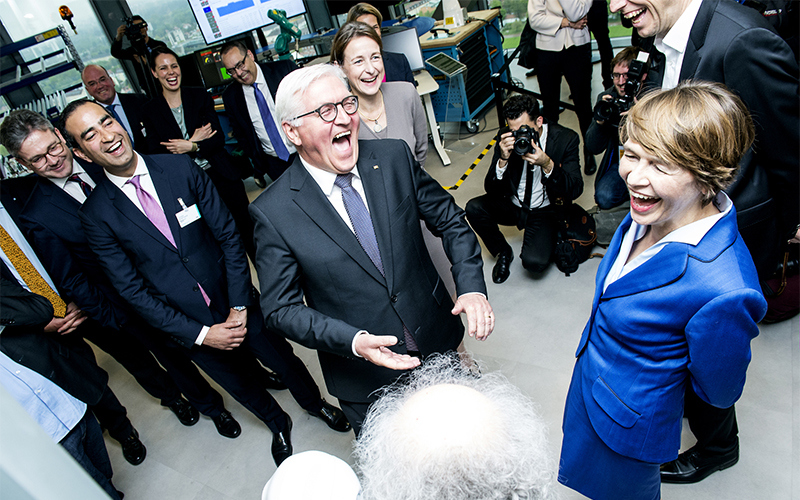IoT
How Collaboration is Driving IoT Innovation
April 26, 2017 | Written by: Sanjay Brahmawar
Categorized: Internet of Things | IoT
Share this post:
One of the most transformative qualities of the Internet of Things is when one connected device teams with another to collaborate on sharing information. From robots on the assembly line floor exchanging data about everything from equipment health to the quality of the items in production, to the drones used to inspect cell phone towers, constant, complex real-time teaming to share data is at the core.

Federal President of Germany, Frank-Walter Steinmeier and First Lady Elke Büdenbender, visiting the industry’s first cognitive collaboratories at IBM’s global Watson Internet of Things (IoT) headquarters in Munich. Joining them to the President’s left and right, respectively, are Sanjay Brahmawar, IBM GM of Watson IoT Sales, and Martina Koederitz, GM of IBM DACH.
This is the IoT ecosystem at work. Connected devices in IoT do not operate in a vacuum and neither can the engineering and development teams who are responsible for their creation. More and more we are witnessing IoT’s ability to not only knock down innovation walls, but physical ones as well, bringing teams from different companies and industries together in a collaborative environment focused on possibilities.
This week the President of Germany Frank-Walter Steinmeier will be visiting our IBM Watson IoT Headquarters in Munich for this very reason – to witness this power of IoT collaboration firsthand. The visit is part of the President’s country-wide tour dedicated to seeing how businesses and universities are collaborating to turn Germany into the global center of IoT.
Having the President visit our offices is an honor for our team and a significant endorsement of the “collaboratories” and the work that’s happening therein. These centers are real launching pad for innovation and the possibilities for new solutions are unlimited.
For example, just last week we announced new Voice-Enabled Cognitive Room solutions that was a result of a teaming between IBM and HARMAN, which has a team collocated in our Munich offices. And today we added our latest partner, fortiss, a research institute associated with the Technical University of Munich.
Right now, fortiss’s team of PhD and postgraduates are setting up shop in our collaboration centers where they will work side-by-side with IBM to augment their (research) products with new IoT and cognitive capabilities that make them “smarter.”
Initially their focus will be to infuse cognitive capabilities into robots, enabling them to learn and decide on their own and improve specific tasks. They are also looking to make manufacturing processes smarter by applying cognitive IoT capabilities that allow systems to more easily adapt to business challenges such as the ability to enable more flexible production.
Whether it’s manufacturing, precision farming, healthcare, retail, insurance or banking, IoT offers companies a truly transformative opportunity, but it cannot be reached without the presence of a team. It’s through an IoT collaboration that an idea can become a reality.
AI and IoT Help Perfect the Brew at Sugar Creek Brewing Company
Beer-making is one of the oldest and largest industries in the world. Hundreds of years ago, European Monks refined brewing techniques to create some of the most well-known varieties of ale. Then, during the Industrial Revolution, technology like hydrometers and thermometers gave brewers more control of the beer making process, yielding a more predictable product […]
Sears Home Services, Golden State Foods Turn to IBM IoT
Experts predict there will be 20.4 billion “connected things” deployed by 2020. The billions of sensors on these Internet of Things (IoT) devices are already generating tons of data. Through exciting new innovations in data management and analytics, companies are beginning to exploit this data to cull critical insights that can be used to positively […]
Watson IoT Takes to the Manufacturing Floor
Much of the discussion at Hannover Messe 2017, the world’s largest annual industrial fair, will center on the fourth revolution of industry, or, simply, Industry 4.0. While Industry 4.0 is a relatively new topic, it has deep roots that tie back more than 200 years to the first industrial revolution when new manufacturing processes came […]



